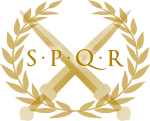Decurion (Roman cavalry officer)
 | ||||
| Part of a series on the | ||||
| Military of ancient Rome | ||||
|---|---|---|---|---|
| Structural history | ||||
|
||||
| Campaign history | ||||
| Technological history | ||||
|
||||
| Political history | ||||
|
|
||||
| Strategy and tactics | ||||
|
||||
|
| ||||
- Not to be confused with Decurion (administrative)
A decurion (Latin: decurio, plural decuriones) was a Roman cavalry officer in command of a squadron (turma) of cavalrymen in the Roman army.
Republican army
During the Roman Republic a "Polybian" legion (ca. 300–88 BC) of citizen-levies had a cavalry complement of 300 horse, divided into 10 turmae (squadrons) of 30 men each. Each turma was led by 3 decurions, who were elected by the squadron members themselves. Although decurio literally means "leader of 10 men", it does not appear that a turma was sub-divided into 3 troops of 10 men each. Instead, one decurion would act as squadron commander and the other two as his deputies.[1] All decurions were members of the Roman equestrian order, as were many of their subordinates.
Imperial army
In the imperial Roman army of the Principate (30 BC - AD 284), a decurion also commanded a cavalry turma of ca. 30 men, but now without colleagues. In common with all soldiers in the imperial army, decurions were long-service professionals, the majority volunteers.
A Roman imperial legion, which contained ca. 5,600 men, contained a small cavalry arm of just 120 men (i.e. 4 turmae). Since the average number of legions deployed was ca. 30, imperial legionary cavalry numbered only ca. 3,600, out of a total of ca. 80,000 cavalrymen deployed by the imperial army. There were thus ca. 120 cavalry decurions in the legions at any given time.
The vast majority of the imperial cavalry was in the regiments of the auxilia, the non-citizen corps of the regular imperial army (whose recruits were mainly imperial subjects who did not hold Roman citizenship (known as peregrini). An ala (literally "wing"), which was an elite all-cavalry regiment, contained 480 horse (16 turmae, thus 16 decurions). A double-strength ala (ala milliaria) contained 720 horse (24 turmae). Circa 90 alae were deployed in the time of emperor Hadrian (ruled 117-38). In addition, the auxiliary corps included a type of regiment known as a cohors equitata, an infantry unit with a cavalry complement of 120 horse (4 turmae; 8 in a double-strength unit). Around 180 such regiments existed under Hadrian. There were thus ca. 2,500 decurions serving in the auxilia at any given time.
In the imperial period, decurions were no longer conscripted Romans, commoners who were often promoted from the ranks, but could also be members of native tribal aristocracies. (Roman knights at this stage only provided the overall commanders (praefecti) of the auxiliary regiments.) Thus, decurions in the imperial army were of far lower social status than their predecessors in the Republican cavalry. The latter were not only Roman citizens, but also aristocrats, whereas auxiliary decurions were mostly commoners and non-citizens (until AD 212, when all imperial subjects were granted citizenship). Even if they belonged to a native aristocracy, they ranked lower than a commoner Roman citizen in the status-conscious Roman empire.
References
- ↑ Polybius VI.25